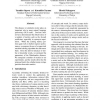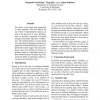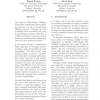COLING
2008
14 years 1 months ago
2008
In this paper, we present an approach to the automatic identification and correction of preposition and determiner errors in nonnative (L2) English writing. We show that models of...
COLING
2008
14 years 1 months ago
2008
The distance or similarity metric plays an important role in many natural language processing (NLP) tasks. Previous studies have demonstrated the effectiveness of a number of metr...
COLING
2008
14 years 1 months ago
2008
Quickly moving to a new area of research is painful for researchers due to the vast amount of scientific literature in each field of study. One possible way to overcome this probl...
COLING
2008
14 years 1 months ago
2008
We report on the large-scale acquisition of class attributes with and without the use of lists of representative instances, as well as the discovery of unary attributes, such as t...
COLING
2008
14 years 1 months ago
2008
Translation model size is growing at a pace that outstrips improvements in computing power, and this hinders research on many interesting models. We show how an algorithmic scalin...
COLING
2008
14 years 1 months ago
2008
Finite-state Transducers (FST) can be very efficient to implement inter-dialectal transliteration. We illustrate this on the Hindi and Urdu language pair. FSTs can also be used fo...
COLING
2008
14 years 1 months ago
2008
One style of Multi-Engine Machine Translation architecture involves choosing the best of a set of outputs from different systems. Choosing the best translation from an arbitrary s...
COLING
2008
14 years 1 months ago
2008
COLING
2008
14 years 1 months ago
2008
We present an algorithm for unsupervised induction of labeled parse trees. The algorithm has three stages: bracketing, initial labeling, and label clustering. Bracketing is done f...
COLING
2008
14 years 1 months ago
2008
Och's (2003) minimum error rate training (MERT) procedure is the most commonly used method for training feature weights in statistical machine translation (SMT) models. The u...



